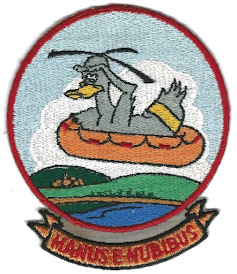'MANUS E NUBIBUS'
"THE HAND FROM THE CLOUDS"
Here are a couple of patches from the 83rd Air Rescue Squadron, the one on the left probably being the early version of the patch with the one on the right being slightly later. Both made in the 1950's.
Air Rescue Squadron
The 83d Air Rescue Squadron was activated when the Air Rescue Service directed Air Rescue Group Flights to organize squadrons in 1952. Originally the 83d was the 12th Air Rescue Group C Flight. Established on August 12, 1952, and activated on September 1, 1952, at Palm Beach International Airport, the 83d Air Rescue Squadron operated SH-19's under the 12th Air Rescue Group. Shortly after, it relocated to Bordeaux, France, attached to the 12th Air Force. On August 1, 1953, the squadron moved to Spangdahlem AB, Germany, and was reassigned to the Commander-in-Chief USAFE on August 1, 1954. The unit was inactivated on December 8, 1957.
War on Terror
Remaining inactive for nearly 50 years, the squadron was redesignated as the 83d Expeditionary Rescue Squadron. It was granted provisional status, it was placed under Air Combat Command with the authority to activate or deactivate on or after April 14, 2003.
The squadron was eventually activated at Bagram, Afghanistan, operating HH-60G helicopters and was assigned to the 455th Air Expeditionary Wing, established in Afghanistan in April 2002. Drawing personnel from various components of the USAF—active, reserve, and air national guard—the squadron formed diverse crews deployed for tours of duty.
Members of the 83rd Expeditionary Rescue Squadron prepare to board an HH-60G Pave Hawk on Bagram Airfield, Afghanistan, March 12, 2013. The 83rd ERQS Guardian Angel is a small tactical unit that trains and executes their mission in personnel recovery throughout eastern Afghanistan. (USAF Photo/Senior Airman Chris Willis)
French Pilots Rescued
On June 11, 2011, the 83d sprang into action following a French Air
Force Gazelle crash in Afghanistan due to severe weather. The squadron aborted
a night-time training mission, deploying two Pavehawks escorted by two US Army
AH-64 Apaches to provide security. Locating the French pilots swiftly, the
pararescue team found the pilot with a broken back, and the co-pilot, still
inside the Gazelle, underwent a cricothyrotomy procedure to establish a patent
airway. The entire rescue operation took just nine minutes, described by TSgt.
Burridge as one of the fastest he had ever witnessed.
Recognizing the gravity of the co-pilot's injuries, Capt. John Mosier, the
Pavehawk pilot directed Chalk II to swiftly head to the Craig Joint Theatre
Hospital at Bagram Air Field. Meanwhile, SrA Jackson Rogers and SrA Andrew
Nichols, pararescue jumpers from the
83rd ERQS, loaded the pilot into the other aircraft. Regrettably, the co-pilot
succumbed to his injuries while receiving treatment at the hospital. French
officials expressed deep appreciation for the prompt and effective actions of
the 83rd ERQS airmen, noting their courage, professionalism, and unwavering
dedication to duty as the highest example.
French Brig. Gen. Emmanuel Maurin, Task Force La Fayette IV commander,
honoured Capt. John Mosier (HH-60G Pave Hawk pilot, 33rd RQS), Tech. Sgt.
Kristopher Burridge (31st RQS), and Senior Airman Jackson Rogers (31st RQS),
presenting them with the National Defence Gold Medal adorned with bronze star
medals. This recognition celebrated their heroic actions in rescuing two French
Gazelle helicopter pilots.
(USAF Photo/SSgt.Wes Wright)
The crews wore the traditional diamond Pedro patch although it was changed by a later crew to a new design (below).
Made by crews from the 210th RQS when deployed to Afghanistan & was an alternative to the original diamond generic patch.
The Squadron was deactivated c.2018 after the US Army took over the role operating CH-47 Chinooks.

.png)




No comments:
Post a Comment